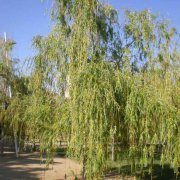Care of the tree Salix babylonica or Weeping willow |
|
The genus Salix, family Salicaceae, comprises 300 species native to the Northern Hemisphere. Some species are: Salix babylonica, Salix fragilis, Salix cinerea, Salix alba, Salix purpurea, Salix arbuscula, Salix viminales, Salix caprea, Salix atrocinerea, Salix vitellina. Common names: Babylon willow, Weeping willow. This species is native to northern China. They are evergreen trees with elegant bearing and hanging branches that reach 25 meters (82 feet) in height. They have simple, alternate, linear-ovate leaves. The tiny dioecious flowers without petals appear in long cylindrical catkins. They bloom in spring. The seeds are covered with long hairs that allow them to be dispersed by the wind. Weeping willow is used to fix riverbanks and slopes and as isolated specimens. Salix baylonica needs full sun exposure but also grows in semi-shade. It resists frost down to -7 ºC (19.4 ºF). Babylon willow prefers clay soils. Transplanting and planting are done in the fall or spring. Salix babylonica does not resist drought; water frequently throughout the year. Fertilize with compost or manure in the fall. Prune intensively in early winter. Weeping willow can be attacked by the fungus Fusicladium, by caterpillars and by mealybugs. Salix babylonica is propagated by woody cuttings in the fall. The seeds do not usually germinate. |
Images of the tree Salix babylonica or Weeping willow |
Find plants
Salix babylonica or Weeping willow | Care and Growing
© 2026 FavThemes



